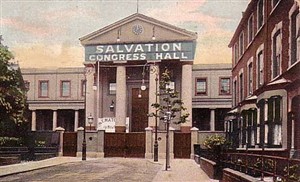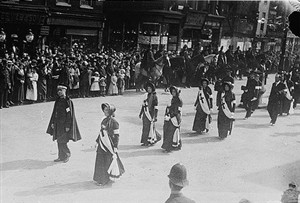
In its heyday, the Congress Hall in Clapton attracted more worshippers than any other place in Hackney
© unknown

Thousands of people lined the streets as William Booth's funeral procession made its way to Abney Park cemetery in 1912
© George Grantham Bain Collection, Library of Congress
By Natasha Lewer
Training centres
When William and Catherine moved out of their house in Gore Road in 1880, the house became a training centre for female Salvationists, while men were trained at 259 Mare Street, then known as Devonshire House.
Congress Hall
More space became needed, and in the early 1880s the Salvation Army acquired and converted the former London Orphan Asylum in Lower Clapton. They demolished the chapel there, and excavated and roofed over the quadrangle, creating a hall that could seat 4,700 people. The wings of the building became a training barracks – including classrooms, workrooms and bedrooms – that could accommodate 150 male and 150 female cadets at a time, all of whom were committed to furthering the Salvation Army’s mission.
Such was the Salvation Army’s success in Hackney that at the turn of the 20th century, more people came to services at the Congress Hall than at any other place of worship in the area. On one random Sunday in 1903, the morning service attracted 913 worshippers, while 1,635 came in the evening.
It would be wrong to think they were popular with everyone in the area. A local policeman, Inspector Fitzgerald, interviewed in the late 1890s about the area around Linscott Road and Laura Place, remarked disparagingly: "The district is the stronghold of the Army. The Salvationists have drummed all the best people away."
Corps and citadels
Although the Clapton Corps of the Salvation Army was the largest in the area, there was also a Cambridge Heath Corps, based at 24 Shore Road, off Well Street, and a Homerton Corps based at 66 Halidon Street. The Cambridge Heath Citadel was opened in 1908, at 72 Cambridge Heath Road (just north of St Joseph's Hospice on what is now Mare Street); after being bombed in the Second World War, it was rebuilt in 1957 and is still in use by the Salvation Army today.
Meeting halls
Numerous halls in Hackney were registered for use by the Salvation Army, including the People's Hall in Havelock Road, off Well Street; the Clapton Park Theatre in Glenarm Road; Hedgers Grove Hall at 383 Kingsland Road; a hall in Hedgers Grove off Cassland Road; a hall behind 98 Homerton High Street; a hall in Lawrence Buildings, Stoke Newington; and the Florence Booth Hall in Valette Street, central Hackney. There was also a mission house in Rossington Street, Upper Clapton.
Funeral crowds
Huge crowds attended the lying-in-state at the Congress Hall of Catherine Booth in 1890, of William Booth in 1912, and eventually of Bramwell Booth in 1929, and old photographs show black-clad crowds thronging Stoke Newington High Street as the funeral processions made their way to Abney Park, where they – and many other Salvation Army notables – are buried.
Image of Clapton Congress Hall reproduced courtesy of www.sacollectables.com.